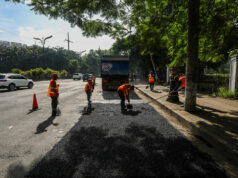BSP sees lag in effects of monetary easing moves
IT MAY TAKE a while before the financial system fully feels the impact of the easing moves implemented by the central bank this year, according to Bangko Sentral ng Pilipinas Governor Benjamin E. Diokno, with its decision to hold steady to help it assess how the market is taking past cuts.
“Monetary policy works with lag so ‘di pa namin nakikita yung impact ng ginawa naming rapid fire, 75 basis points (bps) [of key interest rate cuts] tapos 400 basis points dun sa RRR (reserve requirement ratio). (we have yet to see the impact of the rapid fire easing we’ve done — 75 bps in key interest rate cuts and 400 bps in RRR reductions),” Mr. Diokno told reporters at the sidelines of the launch of the EGov Pay Facility and QR PH held at the central bank on Wednesday.
“In fact, you can argue na yung impact nung 175 basis points [hike] pa nagpi-feed (what’s still being felt is the 175 bps hike in policy rates)… So let’s see,” he added.
The BSP hiked interest rates by 175 bps last year as inflation hit multi-year highs. However, it cut key rates by 75 bps earlier this year amid easing prices, partially dialling back its tightening last year.
Rates for overnight reverse repurchase, overnight deposit and lending facilities currently stand at four percent, 3.5% and 4.5%, respectively.
Meanwhile, the reserve ratio of universal, commercial and thrift banks will be slashed by another 100 bps effective December, bringing total reductions to their reserve ratios for this year to 400 bps. This cut will also apply to the reserve ratio of non-bank financial institutions with quasi-banking functions (NBQBs).
This will bring the reserve ratio of universal and commercial lenders to 14% by December, while the RRR of thrift banks will stand at four percent. On the other hand, the reserve ratio of NBQBs will be cut to 14% next month, while the RRR for rural banks will remain at three percent.
Mr. Diokno said it could take six to nine months for the BSP’s policy actions to fully work their way into the financial system.
“Ang monetary policy, ang lag nyan is mga nine months. So dapat talaga monetary policy should be forward-looking (Monetary policy’s lag is about nine months. So monetary policy should really be forward-looking),” he said, adding that RRR reductions may take about six to nine months before these are felt in the market.
“But at the same time, yung (our) pause namin gives us an opportunity to assess the situation. It gives us, in the event of, say, turning for the worst, madami pa tayong bala (we still have shots),” he told reporters.
Asked about when the next RRR cut will be, Mr. Diokno reiterated his goal to bring big banks’ reserve requirement ratio down to single digit by the end of his term in 2023.
“I’m not gonna give you some dates but to give you an idea, sa promise ko (my promise) is by the end of my term, it will be single digit. That could be nine percent. We’re not gonna go to one percent,” he said, adding that the central bank is “not in a hurry.”
“Ini-evaluate din namin yung quality of lending ng banking industry (We’re also evaluating the quality of the banking industry’s lending,” he said.
Mr. Diokno added that he is positive that economic activity will be more robust on the back of the government’s infrastructure program.
“Ang gusto namin yung small and medium industries sila yung manghihiram. (What we want is for small and medium industries to borrow)… So we need more liquidity,” he said.
BSP data showed that domestic liquidity picked up by 7.7% year-on-year in September to P12 trillion, from the 6.3% growth logged in August.
Meanwhile, outstanding loans disbursed by universal and commercial banks grew 10.5% year-on-year in September, unchanged from the August print. Inclusive of reverse repurchase agreements, bank lending rose 10.2% in September, slightly picking up from the 10% seen the previous month. — L.W.T. Noble



